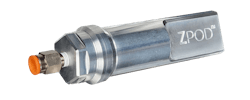Aircraft maintenance needs fluctuate based on the climate where the plane in question logs most of its hours. Pilots, servicemen, and businesses that tune-up commercial and private aircraft utilize different techniques when it comes to making sure planes — regardless of the environment in which they fly — are safe, well maintained, and running smoothly. One crucial element in ensuring the health of an aircraft is engine maintenance and upkeep; a major component is the use of the proper oil, and an appropriate service/oil change schedule.
Choosing the right oil and viscosity grade for an aircraft’s main operating environment is critical to a successful maintenance program. Viscosity is, in layman’s terms, a measure of how quickly an oil flows at a given temperature. The lower the viscosity, the more quickly the oil will flow at startup. While most aircraft owners understand the basics of lubrication, the difference between viscosity grades, and the benefits of each, often creates some confusion. As the aviation industry begins to further understand the science behind multigrade aviation oil — as well as the key features and benefits of these products — those who fly or care for airplanes will be better equipped to improve engine performance and potentially extend the operating life through more specialized engine maintenance, whether in the dog days of summer or the dead of winter.
Multiviscosity oils and Aviation 101
Over time, multiviscosity oils have become the standard for nearly all automotive, trucking, and heavy-duty equipment applications, but have yet to take a strong foothold in aviation. Prior to the increase in popularity of multiviscosity products, the only oil that was available for use on aircraft was monograde, otherwise known as single-grade or straight grade. These monograde oils have inferior lubricating properties because the difference in viscosities varies too much between temperature extremes. As engineers and mechanics sought improved lubrication, scientists formulated oil that would impart enhanced lubrication properties in freezing cold temperatures and boiling hot weather, by utilizing polymers. These polymers — the building blocks of multiviscosity oils — not only allow cold temperature startup capabilities, but also provide increased protection in high temperature climates.
While the automotive industry was the first to overwhelmingly adopt the use of multiviscosity oils, and continues to utilize the technology today, only half of the aviation industry has made the switch. Despite their slow adoption by aircraft owners, operators, and mechanics, multiviscosity aviation oils are not new — the first, Phillips 66 X/C 20W-50, was introduced in 1979. Even with nearly 30 years of proven performance in the most demanding applications, not everyone understands the unique performance benefits of multiviscosity aviation engine oils.
Multiviscosity oil stands up to the extremes
The most basic principle behind the effectiveness of multiviscosity aviation oils in any climate is the fact that the product — offering supreme protection — can flow smoothly at low temperatures, yet also properly protect engines in the heat. As most anyone who uses engine oil on a regular basis knows, all lubricants get thinner (or less “viscous”) as their temperature increases, which is the process that allows lubricants to flow freely through an engine. What many people don’t know is that multiviscosity oils are composed of a small amount of polymer, which is designed to provide the best high-temperature protection, along with base oils that offer the greatest cold-temperature properties. This unique design is what makes these oils superior to monogrades, and the smart choice for aircraft in
any environment.
From Alaska to Florida
Inlet Petroleum Company (IPC), the largest distributor of Phillips 66 Aviation Lubricants in the country, is based in Anchorage, AK, and is a firm believer in the power of multiviscosity oils. IPC, which services seasonal and year-round customers, understands the benefits of providing premium products and effective maintenance solutions that help keep planes running well and safely in the bitter cold, and multigrade oils fit in perfectly with that equation.
According to IPC, multiviscosity oils have been one of the most useful tools the company employs when servicing aircraft in the cold weather. The improved cold startup capabilities provided by these oils are a key performance attribute for plane maintenance in Alaska. It is generally accepted that a cold startup is considered to be anything below 60 F. However, an engine at rest is always cold relative to its normal operating temperatures; therefore, the oil is also thick relative to its designed operating viscosity. This makes a multigrade product a key advantage in the frigid climates of Alaska, which frequently experience temperatures much colder than that.
“Our customers use Phillips 66 multiviscosity aviation oils year round and operate in temperatures that can include minus 60 F in the winter,” says Joel Lawrence, marketing manager at Inlet Petroleum Company. “Our climate is the ultimate test for aviation lubricants and these oils prove to be superior time and time again.”
IPC can also take advantage of the fact that in subzero-type climates, before the implementation of multiviscosity oil, mechanics and aircraft owners were forced to drain their aircraft’s engine oil while it was still hot and house the oil at a temperature warm enough to maintain the continued flow of the straight grade oil at the next startup. Now, companies like IPC as well as aircraft mechanics can utilize multiviscosity oils, which allow the oil to remain in the engine not only after each use in freezing temperatures, but year-round, given proper maintenance and oil changes.
While IPC has experience dealing with reasonably warm temperatures at the peak of Alaska’s summer weather, the company can’t compare its familiarity in dealing with heat to the group of highly skilled mechanics and service people at Miami-based Propel Aviation Services. Propel is a full-service maintenance provider for Cessna and other passenger planes, routinely servicing almost every type of Cessna plane, from the smaller 152s to the 208-208B Caravans and the full range of Cessna twins.
As Propel knows very well, one of multiviscosity oil’s greatest strengths when maintaining planes in excruciatingly hot weather is the fact that the oil’s polymers resist thinning as temperatures skyrocket, which allows the product to retain its viscosity. One very specific benefit of using these oils in extreme heat is the ability to protect the ring belt. Given the superior film thickness and clean-burning properties of multiviscosity oils, it is far easier to preserve a clean ring belt area. This allows piston rings to seal against the ring land and cylinder wall, which results in better combustion control. Increased film thickness also prevents oil leakage past the piston rings, reducing buildup. In addition, a pilot will see cleaner crankcase and exhaust systems after switching to multiviscosity oil.
“Heat, humidity, and the fact that Florida is a high salt environment impacts an engine,” says Matt Lee, sales representative for Propel. “In terms of how the weather impacts us, we’re primarily concerned with condensation in the engine, which can cause corrosion, pitting, and more. To combat these problems, we ensure all our aircraft have proper oil levels, and we recommend multiviscosity products to guarantee proper lubrication, which lowers the chances that condensation will create problems.”
What multiviscosity oil means to you
Many advantages exist when using multiviscosity oil as the primary option when maintaining planes in any weather. From providing superior lubrication at cold startup to reducing oil consumption during the heat to maintaining cleaner exhaust systems, multigrade oil will keep aircraft running smoothly no matter what the thermometer reads.
Harold Tucker is the director of technical information and training, ConocoPhillips Commercial Lubricants.





